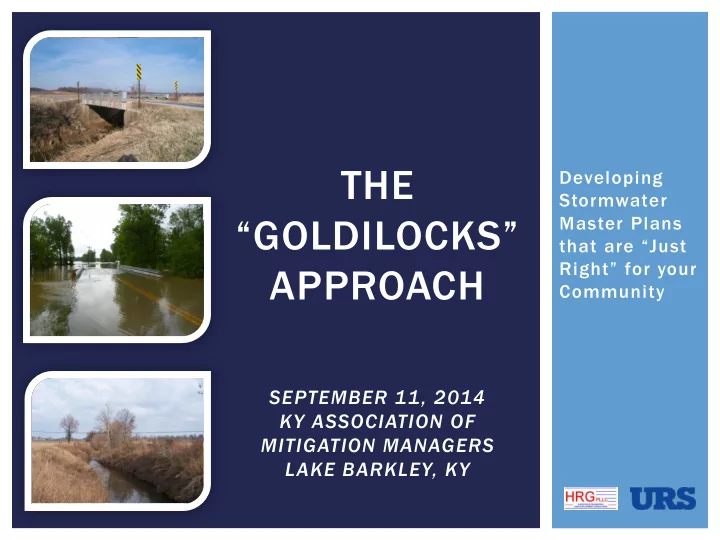

THE Developing Stormwater “GOLDILOCKS” Master Plans that are “Just Right” for your APPROACH Community SEPTEMBER 11, 2014 KY ASSOCIATION OF MITIGATION MANAGERS LAKE BARKLEY, KY
GOLDILOCKS AND STORMWATER “The Story of the Three Bears” Wanders into the home of Papa Bear, Mama Bear, and Baby Bear Tries their soup… one is too hot, another too cold, one is just right Tries out a chair, and one is just right At some point, decides she needs some rest, and finds a bed that is just right… only to be discovered, asleep when the bears come home So… how does this relate to stormwater master planning?
EVERY COMMUNITY IS DIFFERENT Political Economic What does a Physiographic stormwater plan look like that is “just right” Topography for my community? Stormwater System Severity of flooding
OVERVIEW Project Background Study Purpose Study Area Project Approach/Methods Scoping Data Collection Baseline Modeling Goals Assessment Alternatives Analysis Lessons Learned/Conclusions
PROJECT BACKGROUND Purpose and Study Area
STUDY AREA Owensboro
HISTORIC FLOODING
STUDY STREAMS
Our Study PROJECT APPROACH and the Methods We Used
DEFINING THE SCOPE What question(s) do we want to answer? What is the appropriate level of detail? What methods will this require?
THE LOCAL ADVANTAGE Local officials: Manage your consultant! Express your concerns Be satisfied with the project goals – if not, let it be known Stakeholders Local Partner – Jim Riney, HRG PLLC County Officials Drainage Advisory Committee Public Meeting
DATA COLLECTION Find the low- hanging fruit Studies done locally State GIS data LiDAR KYTC Record Drawings Data from Federal Agencies FEMA studies USGS gages
BASELINE STUDIES Steady-State 9 of the 12 study streams Unsteady-State Panther Creek system (Panther, NF, SF) Understand combination of backwater and headwater effects
BASELINE STUDIES Begin with the end in mind Models can be built upon if more detailed studies are needed in the future Models can be leveraged in future FEMA floodplain mapping efforts Modeling of historic flood events Calibration/verification (NEXRAD, USGS, HWM) Communicates in terms of a flood locals know Can be used for “what if” scenarios
STUDY AREA Owensboro
ANIMATION
GOALS ASSESSMENT Alternatives Pilot study to test initial project goals Roadway serviceability 2 streams Raising of roadway 2 Events (2 yr, 100 yr) profile Roadway serviceability Bridge replacement All roads? Floodplain Or just major roads? Reduction Floodplain Reduction Detention 0% Levees 25% 50%
GOALS ASSESSMENT Coun unty ty-wide ide Cost st Estimat mate e using ing Det etentio ion Model & 100-yr spreadsheet 2-yr calculations to obtain quantities Amount of detention Miles of roadway Cost raised, average height # of Bridge Replacements Performed cost estimates 0% 10% 20% 30% 40% 50% 60% Percent ntage age of Floodplain ain Reduc uction on Selected final goals
ROADWAY MODIFICATIONS Roadway KYTC Functional Classes Functional Modifications Description Class Rural Interstate 1 Modeled WSEL Urban Interstate 1 LiDAR bridge/roadway Rural Principal Arterial 2 Urban Freeways & Expressways 2 elevations Urban Principal Arterial 3 Rural Minor Arterial 4 KYTC Bridge Plans Urban Minor Arterial Street 4 Rural Major Collector 5 KYTC Functional Urban Collector Street 5 Classification System Rural Minor Collector 6 Rural Local Road 7 Urban Local Road 7
ROADWAY MODIFICATIONS
ALTERNATIVES ANALYSIS Alternatives Apply goals to all Roadway study streams serviceability 12 streams Raising of roadway 5 Events (2, 10, 25, profile 50, 100 yr) Bridge replacement Roadway serviceability Floodplain Reduction Major roads only (based on KYTC functional Detention classification) Levees Floodplain Reduction Channelization 30% reduction goal Straightening
ALTERNATIVES ANALYSIS Cost vs Flood d Event nt (All l St Streams) ams) llars 100 yr in Doll n Cost, in 50 yr 25 yr truction Constructio 10 yr 2 yr 0 20 40 60 80 100 120 Recurre urrence nce In Interval al of Flo lood d Eve vent nt, in in Year ars
What are CONCLUSIONS the key lessons?
CONCLUSIONS Overall Establish a level of detail that is appropriate to the question being asked Manage the consultant – be happy with the result of the scoping process Find methods that are appropriate to the scale of the problem at hand Stakeholder involvement Technical Finding low hanging fruit: Leveraging existing data LiDAR, KYTC Bridge Plans, FEMA studies, Previous Studies Begin with the end in mind: Create models that can be used later Can be built upon if more detailed studies are needed Can be leveraged for more FEMA floodplain mapping Model historic events: A number of benefits Model calibration, public outreach, “what - if” scenarios
THANKS! Thanks to Mark Brasher, County Judge Executive Al Mattingly, Commissioners George Wathen, Charlie Castlen, and Jim Lambert, and the Daviess County Drainage Advisory Committee! Thanks to Jim Riney, HRG
Recommend
More recommend